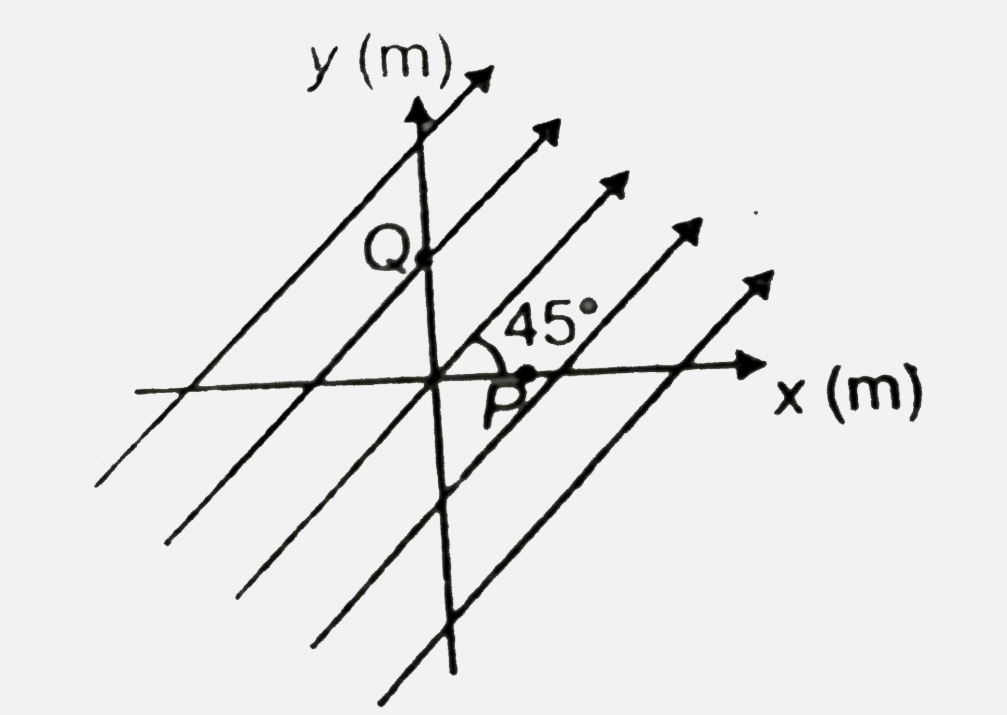A constant electric field of intensity 36N/C exists along the z-axis. If P and be two points whose coordinates are (10 cm, 0, -20 cm) and (0, -10 cm, 30 cm) respectively, then find the potential difference VP−VQ. Solution in Telugu
The correct Answer is:18V
Step by step video, text & image solution for A constant electric field of intensity 36N/C exists along the z-axis. If P and be two points whose coordinates are (10 cm, 0, -20 cm) and (0, -10 cm, 30 cm) respectively, then find the potential difference V_(P)-V_(Q). by Physics experts to help you in doubts & scoring excellent marks in Class 12 exams.
Updated on:21/07/2023Topper's Solved these Questions
- ELECTRIC FIELD AND POTENTIALBook:AAKASH SERIESChapter:ELECTRIC FIELD AND POTENTIALExercise:PROBLEMS (LEVEL-II)
Explore 32 Videos
- ELECTRIC FIELD AND POTENTIALBook:AAKASH SERIESChapter:ELECTRIC FIELD AND POTENTIALExercise:EXERCISE (VERY SHORT ANSWER QUESTIONS)
Explore 23 Videos
- ELECTRIC CHARGES AND FIELDSBook:AAKASH SERIESChapter:ELECTRIC CHARGES AND FIELDSExercise:Practice Exercise
Explore 57 Videos
- ELECTROMAGNETIC INDUCTIONBook:AAKASH SERIESChapter:ELECTROMAGNETIC INDUCTIONExercise:Additional Exercise
Explore 10 Videos
Similar Questions
A metal sphere with its centre at A and radius R has a charge 2q on it. The field at a point B outside the sphere is E. If another metal sphere of radius 3R and having a charge -3q is placed with its centre at point B, find out the resultant electric field at a point mid way between A and B.
View SolutionUsually it is the negative charge that is transferred when two bodies are rubbed together. Can you explain. Why?
View SolutionWat is the charge acquired by a body when one million electrons are transferred to it.
View SolutionConsider Experiment II in Section 6.2.
a. What would you do to obtain a large deflection of the galvanometer?
b. How would you demonstrate the presence of an induced current in the absence of a galvanometer?
View SolutionA spherical shell of radius 10 cm is carrying a charge q. If the electric potential at distances 5 cm, 10 cm and 15 cm from the centre of the spherical shell is V_(1), V_(2) and V_(3) respectively, then
View SolutionA uniform electric field is along x-axis. The potential difference V_(A)-V_(B)=10 V is between two points A (2m, 3m) and (4m, 8m). Find the electric field intensity.
View SolutionAn electric field of 10 N/C exists along the x-axis in space. Calculate the potential difference VB−VA where the points A and B are given by -
(a) A = (0, 0), B = (8m, 3m), (b) A = (8m, 3m) , B = (12m, 6m)
(c) A = (0, 0) , B = (12m, 6m)
View SolutionCalculate the magnitude and direction of the electric field at a point P which is 30 cm to the right of a point charge Q = -3.0 xx 10^(-6) C
View SolutionA uniform electric field of 200 V / m is directed at 45∘ with x -axis as shown in figure. The co-ordinates of point P and point Q are (1,0) and ( 0,2) . Find the potential difference , VP−VQ ( in volts) .

View Solutionकिसी गोले के केंद्र से 20 सेमी. दूर स्थित एक बिंदु पर विद्युत क्षेत्र की तीव्रता 10 वोल्ट/मीटर है। उस गोले के केंद्र से 8 सेमी दूरी पर स्थित बिंदु पर विद्युत क्षेत्र की तीव्रता ज्ञात कीजिए। गोले की त्रिज्या 5 सेमी. है।
View SolutionThe electric field in a certain region is given by E=5ˆi−3ˆjkv/m. The potential difference VB−VA between points a and B having coordinates (4, 0, 3) m and (10, 3, 0) m respectively, is equal to
View SolutionTwo point charges of magnitude 4 mu C and-4 mu C are kept at points (-2 cm, 0) and (2 cm, 0) respectively. Calculate the magnitude of electric field intensity at points (0, 2 cm).
View Solution20μC মানের একটি আধান একটি তড়িৎক্ষেত্র তৈরি করে । আধানটি থেকে 10 cm এবং 5 cm দূরে দুটি বিন্দু A এবং B আছে | A বিন্দুটিতে তড়িৎবিভব
View SolutionTwo circles whose radii are 10 cm and 8 cm respectively, intersect each other at the points P and Q and their common chord is 12 cm in length. Find the distance between the centers of the two circles.
View SolutionAssum that an electric field →E=30x2ˆiexists in space. Then the potential difference VA−V0, where V0 the potential at the origin and VA the potential at x = 2 m is :
View Solution

